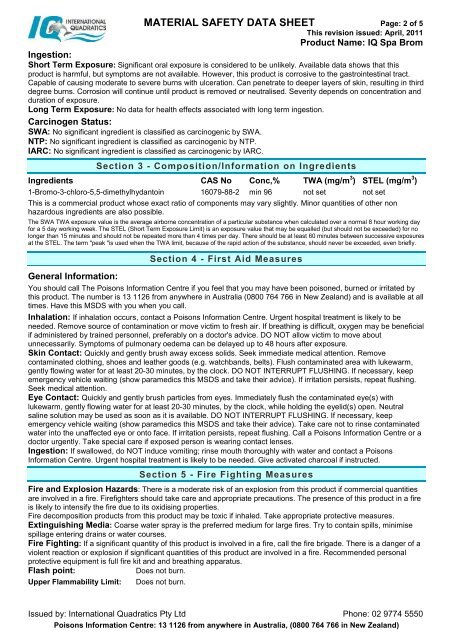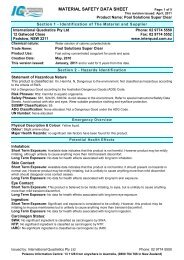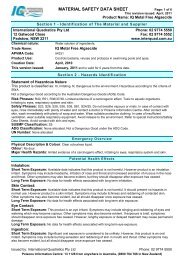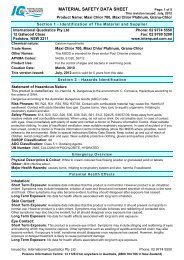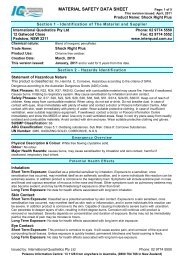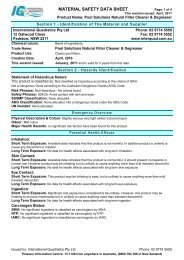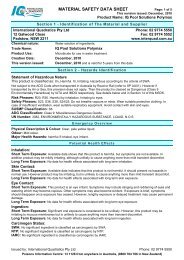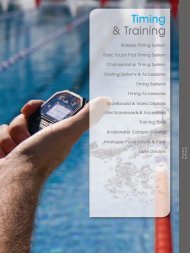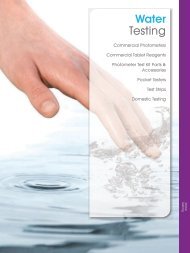IQ Spa Solutions Spa Brom
IQ Spa Solutions Spa Brom
IQ Spa Solutions Spa Brom
You also want an ePaper? Increase the reach of your titles
YUMPU automatically turns print PDFs into web optimized ePapers that Google loves.
MATERIAL SAFETY DATA SHEET Page: 2 of 5This revision issued: April, 2011Product Name: <strong>IQ</strong> <strong>Spa</strong> <strong>Brom</strong>Ingestion:Short Term Exposure: Significant oral exposure is considered to be unlikely. Available data shows that thisproduct is harmful, but symptoms are not available. However, this product is corrosive to the gastrointestinal tract.Capable of causing moderate to severe burns with ulceration. Can penetrate to deeper layers of skin, resulting in thirddegree burns. Corrosion will continue until product is removed or neutralised. Severity depends on concentration andduration of exposure.Long Term Exposure: No data for health effects associated with long term ingestion.Carcinogen Status:SWA: No significant ingredient is classified as carcinogenic by SWA.NTP: No significant ingredient is classified as carcinogenic by NTP.IARC: No significant ingredient is classified as carcinogenic by IARC.Section 3 - Composition/Information on IngredientsIngredients CAS No Conc,% TWA (mg/m 3 ) STEL (mg/m 3 )1-<strong>Brom</strong>o-3-chloro-5,5-dimethylhydantoin 16079-88-2 min 96 not set not setThis is a commercial product whose exact ratio of components may vary slightly. Minor quantities of other nonhazardous ingredients are also possible.The SWA TWA exposure value is the average airborne concentration of a particular substance when calculated over a normal 8 hour working dayfor a 5 day working week. The STEL (Short Term Exposure Limit) is an exposure value that may be equalled (but should not be exceeded) for nolonger than 15 minutes and should not be repeated more than 4 times per day. There should be at least 60 minutes between successive exposuresat the STEL. The term "peak "is used when the TWA limit, because of the rapid action of the substance, should never be exceeded, even briefly.General Information:Section 4 - First Aid MeasuresYou should call The Poisons Information Centre if you feel that you may have been poisoned, burned or irritated bythis product. The number is 13 1126 from anywhere in Australia (0800 764 766 in New Zealand) and is available at alltimes. Have this MSDS with you when you call.Inhalation: If inhalation occurs, contact a Poisons Information Centre. Urgent hospital treatment is likely to beneeded. Remove source of contamination or move victim to fresh air. If breathing is difficult, oxygen may be beneficialif administered by trained personnel, preferably on a doctor's advice. DO NOT allow victim to move aboutunnecessarily. Symptoms of pulmonary oedema can be delayed up to 48 hours after exposure.Skin Contact: Quickly and gently brush away excess solids. Seek immediate medical attention. Removecontaminated clothing, shoes and leather goods (e.g. watchbands, belts). Flush contaminated area with lukewarm,gently flowing water for at least 20-30 minutes, by the clock. DO NOT INTERRUPT FLUSHING. If necessary, keepemergency vehicle waiting (show paramedics this MSDS and take their advice). If irritation persists, repeat flushing.Seek medical attention.Eye Contact: Quickly and gently brush particles from eyes. Immediately flush the contaminated eye(s) withlukewarm, gently flowing water for at least 20-30 minutes, by the clock, while holding the eyelid(s) open. Neutralsaline solution may be used as soon as it is available. DO NOT INTERRUPT FLUSHING. If necessary, keepemergency vehicle waiting (show paramedics this MSDS and take their advice). Take care not to rinse contaminatedwater into the unaffected eye or onto face. If irritation persists, repeat flushing. Call a Poisons Information Centre or adoctor urgently. Take special care if exposed person is wearing contact lenses.Ingestion: If swallowed, do NOT induce vomiting; rinse mouth thoroughly with water and contact a PoisonsInformation Centre. Urgent hospital treatment is likely to be needed. Give activated charcoal if instructed.Section 5 - Fire Fighting MeasuresFire and Explosion Hazards: There is a moderate risk of an explosion from this product if commercial quantitiesare involved in a fire. Firefighters should take care and appropriate precautions. The presence of this product in a fireis likely to intensify the fire due to its oxidising properties.Fire decomposition products from this product may be toxic if inhaled. Take appropriate protective measures.Extinguishing Media: Coarse water spray is the preferred medium for large fires. Try to contain spills, minimisespillage entering drains or water courses.Fire Fighting: If a significant quantity of this product is involved in a fire, call the fire brigade. There is a danger of aviolent reaction or explosion if significant quantities of this product are involved in a fire. Recommended personalprotective equipment is full fire kit and and breathing apparatus.Flash point:Does not burn.Upper Flammability Limit: Does not burn.Issued by: International Quadratics Pty Ltd Phone: 02 9774 5550Poisons Information Centre: 13 1126 from anywhere in Australia, (0800 764 766 in New Zealand)


